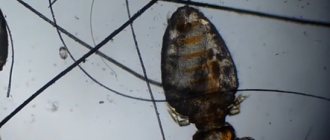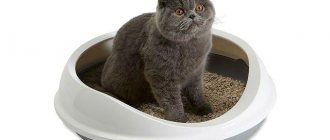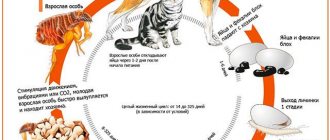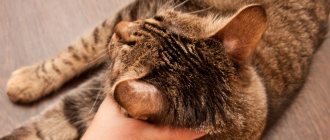Worms in cats: types
Types of worms in cats are classified according to the type of worm:
- Roundworms are nematodes.
- Tapeworms are cestodes.
- Flatworms – flukes, trematodes.
The sizes of helminths vary greatly - from a few millimeters to 1.5 meters. The location of the parasites also differs.
The most common places of parasitism:
- digestive tract;
- liver and bile ducts;
- heart;
- lungs;
- bladder;
- eyes;
- kidneys
The intestines and stomach are most often infected - they are inhabited by toxocara and roundworms. As well as the liver, which is affected by the invasion of the liver fluke.
Medicines for helminths
A veterinarian must treat worms in cats. You cannot select the medicine yourself, since different substances act on different types of helminths. Anti-worm medications are divided into two groups: for external and internal use.
The first group includes drops on the withers. The second includes tablets, suspensions, pastes. There are single-component medications on sale that are used to treat one type of helminthiasis, and multicomponent or combined ones. Such drugs are used for mixed helminthic infestations. They are also often used for prevention.
Important! Before starting treatment, it is advisable to treat the cat for external parasites, since they are often the carriers of helminth infections. Otherwise, re-infection will occur after some time.
Pills
To remove worms from a cat, in most cases it is enough to give her the medicine twice with an interval of 10-14 days. It is important to follow the dosage, which is calculated based on the weight of the animal. Proven and effective remedies for worms in cats in the form of tablets are sold in veterinary pharmacies:
- Drontal. Destroys round and tapeworms.
- Mibelmax. Effectively fights cestodes and nematodes.
- Piperazine. Medicine against roundworms.
- Pirantel. The medicine helps rid the cat of nematodes.
- Pratel. A medicine with a wide spectrum of action, destroys tapeworms, roundworms and flukes.
- Prazicide. Acts only on cestodes and nematodes.
- Vacation. A combined drug based on febendazole and praziquantel with a broad spectrum of action.
- Enwire. Effective against tapeworms and roundworms.
- Trontsil-K. A complex drug used for cestodes and nematodes.
To give a cat an anti-worm tablet, you need to place it on the very root of the tongue, holding the animal by the withers. Next, you need to close your mouth, throw back your head and stroke your neck with your fingers - this will help provoke a swallowing movement. After 10-14 days, the treatment should be repeated.
Attention! Anti-worm medications should not be given to pregnant or lactating cats, or to kittens under one month of age.
Drops on the withers
Some external preparations act on both skin parasites and helminths. These are liquid compositions that are applied to the withers:
- Profender;
- Advocate;
- Stronghold;
- Leopard.
Such medications are suitable for the treatment of certain types of worms in cats - nematodes and cestodes. They are ineffective against trematodes.
Pastes and suspensions
Many drugs that are available in tablet form are also available in the form of suspensions and pastes. They have a more pleasant taste and have a convenient dispenser. These include:
- Albendazole;
- Alvet;
- Kanikquantel plus;
- Prazicide plus.
It is more convenient to treat worms in kittens with a suspension - you can easily measure the required dose. The medicine is poured into the animal's cheek. It is important to ensure that the pet swallows the entire volume, otherwise the therapy may be ineffective.
Nematodes
Roundworms most often parasitize the small intestine, esophagus, and infect the liver. Nematodes are able to penetrate the kitten’s body even when it is in the womb. Therefore, roundworms are most often found in kittens up to 2 months old, while they are feeding on their mother’s milk.
Nematodes are the causative agents of helminth infections such as hookworm disease and toxascariasis.
Hookworm
Hookworm is a round white parasite with a slightly reddish tint, up to 2 cm long, which inhabits the small intestine. The worm bites through the mucous membrane to feed on blood. As a result of its activity, many bleeding wounds appear, which leads to blood loss in the cat. Helminths live in the host’s body, and their larvae exist for a long time in water and soil and move long distances during rain. One female lays up to 16 thousand eggs daily.
Infection occurs in 2 ways:
- Through the mouth, when the cat licks itself, it eats food contaminated with larvae. An outdoor cat becomes infected through the rodents it hunts. Mice are carriers of this type of parasite. In the body of a rodent, hookworms can exist for up to 10 months and remain viable. Entering the cat’s intestines through the mouth, the larva after 2-3 weeks turns into an adult capable of reproduction.
- The larvae burrow through the skin and then migrate through the blood vessels. Hookworms enter the trachea, which causes the pet to cough. When coughing, the larvae enter the mouth, then the animal swallows them, and they end up in the stomach and intestines. After about 3 weeks, a sexually mature worm is formed from the larva.
Routes of infection and general signs of pathology
Most often, parasitic worms enter a cat's body orally, that is, through the mouth. An animal can eat a sick bird or mouse, plants, spoiled food, or drink from dirty water bodies.
You can also become infected with worms from a cat that is already sick. Another method of transmission of parasites is transdermal and intrauterine infection.
The clinical picture of almost all types of worms is the same. First of all, these worms have a negative effect on the organs of the digestive system. The pet refuses to eat, begins to lose weight, and becomes weak. He doesn't want to move, his fur is getting dull.
© shutterstock
Vomiting, nausea, problems with stool, itching in the anal area, gas formation, and blood in the feces are often observed. You can also find the parasites themselves near the anus . When the doctor checks your pet, he will notice that the cat's liver is slightly enlarged.
Flukes, trematodes
Flatworms are much less common in cats. They cause diseases such as paragonimiasis and opisthorchiasis.
Paragonimiasis
The pulmonary fluke or pulmonary fluke is the name of the parasite that causes paragonimiasis. This is an oval-shaped trematode up to 1.5 cm long and up to 1 cm wide. Intermediate hosts are mollusks and crayfish. A cat becomes infected by eating crayfish. From the intestines, the parasite enters the lungs, where it causes bleeding and inflammation.
Symptoms of lung parasites:
- Coughing up blood.
- Wheezing in the lungs.
- Tremor.
- Possible increase in temperature.
- Vomiting foam.
- Diarrhea.
- Lack of appetite.
The pulmonary fluke causes symptoms often similar to those of tuberculosis, bronchitis, and lung cancer. When neglected, it is fatal.
Opisthorchiasis
The liver and gallbladder are parasitized by a species of trematode that causes opisthorchiasis. Opisthorchis worms or cat fluke enter the cat's body through intermediate hosts - fish of the carp family. Flukes damage the walls of the ducts and often cause them to become blocked. Very often, infection creates favorable conditions for the addition of a bacterial infection.
Symptoms of opisthorchiasis:
- Big belly, it hurts.
- Jaundice.
- Upon palpation, the doctor notes thickening of the liver and the presence of tubercles on it.
- Loss of appetite is accompanied by gluttony.
- The fur is tousled.
- Diarrhea alternates with constipation.
- Vomiting with a yellow substance.
Rules for taking medications for worms
Before choosing a deworming drug for your pet, it is necessary to find out by taking tests from a veterinarian what kind of worms the animal is infected with. The veterinarian will prescribe a specific medication and treatment regimen.
As a preventive measure, animals can be given complex-action drugs once a quarter. Pets are also given worming 7-10 days before vaccination!
Before you administer the medicine yourself, you must read the instructions for the medicine. You should not use several different anthelmintic drugs at the same time - the active ingredients may be incompatible with each other!
Features of the treatment of helminthiasis
Against worms, complex preparations are mainly used in the form of tablets, suspensions, drops on the withers, which act against nematodes and trematodes. Despite this, if you suspect worms, you should contact a veterinary clinic to determine the specific type of parasite.
Most anthelmintic drugs are intended for one-time use. However, in case of severe helminthic infestation, re-application will be required 2 weeks after the first treatment.
They begin treatment for worms only after making sure that the cat has no other diseases.
When treating helminthiasis, it is recommended to additionally use Gamavit. This is an immunomodulator.
During pregnancy and lactation, cats are dewormed only when absolutely necessary and under the supervision of a veterinarian.
If kittens are infected in the womb, treatment is allowed only 21 days after birth.
The use of human anthelmintics in cats is strictly prohibited.
Prevention
Comprehensive prevention of nematodes in cats can reduce the risk of infection. The pet, regardless of whether it is outside or not, needs to be given anthelmintic drugs once every 3 months. Even if cats do not have helminths, such a remedy will not harm them.
To reduce the risk of infection, it is recommended to vaccinate your cat promptly. It is necessary to exclude raw fish and meat from entering the animal’s diet. All food must be thermally processed. The water that the cat will drink must be boiled in advance.
It is advisable to protect your pet from going outside and from contact with wild animals. It is necessary to carry out disinfection with special means once every 3 months, using them to treat all the cat’s equipment, incl. sleeping place, scratching posts, etc. In addition, it is necessary to regularly clean the premises using bleach.
All information posted on the site is provided in accordance with the User Agreement and is not a direct instruction to action. We strongly recommend that before using any product, you must obtain a face-to-face consultation at an accredited veterinary clinic.
Danger to humans
There are helminthiases that can be transmitted from pets to humans:
- alveococcosis;
- diphyllobothriasis;
- dipylidosis;
- dirofilariasis;
- toxascariasis.
The main route by which helminths are transmitted to humans is through food and through contaminated hands. The above diseases lead to severe illness and even death. Therefore, deworming of domestic animals is also a primary measure to prevent human infection.
What parasites and how are they transmitted to humans from cats?
Having a pet, especially a cat, is an almost 100% guarantee that all family members, and especially small children, will be affected by worms if they do not follow certain rules. Never kiss or allow a cat to lick your face; after any stroking of the cat, even if it was a fleeting movement of the palm on the back or head, you need to wash your hands.
Cats are quite clean, they spend almost all their free time washing themselves and licking their fur, but this neatness can lead to the fact that
parasite eggs are distributed evenly throughout the entire coat from the tip of the nose to the tail.
The tongue is the most dangerous and the biggest spreader of worms. Of the 81 varieties of helminths that can infect cats, more than 35 varieties perfectly take root in the human body, the most dangerous of which are considered toxascarosis, toxocariasis and dipylidia . Therefore, make sure that all family members, especially children, take the problem of personal hygiene seriously, and do not let anyone kiss the cat.
Prevention of parasites in cats
Prevention of parasites is carried out both for animals and for each family member who keeps a cat. An indispensable condition is the prevention of parasites in children. Most often, this means following the usual rules of personal hygiene and residence, good washing of vegetables and fruits, and the necessary heat treatment of all other products. In addition, it is necessary to carry out a preventive anthelmintic course from time to time.
Prevention of parasites in cats in the form of medicinal preventive deworming is carried out:
- Twice every 6 months with free maintenance;
- Twice every 12 months when keeping the animal at home without the possibility of walking.
The owner also needs to prevent the cat from eating rodents (caught rats and mice) , raw fish or meat. The animal's sleeping place, toys, tray and bowls must be thoroughly disinfected and cleaned.
Thus, despite the high probability of helminth infection, you can easily protect your cat (and yourself) from these unpleasant cases, you just need to carefully monitor the condition of your pet and follow simple rules of hygiene and prevention.
Opisthorchiasis
Opisthorchis is a parasite that lives in the bile ducts of cats, dogs, raccoons, wolves and humans. That is, any mammal that eats raw or poorly processed fish can become infected with it. The parasite has a rather complex and “extensive” development cycle.
So, the eggs of an adult living in the bile ducts, along with bile, enter the feces and are released into the external environment. There they, mixed with melt or rainwater, end up in rivers, lakes or ponds. If you're lucky, the egg will be eaten by a freshwater snail - a pond snail. In the body of the latter, the young parasite grows and develops, reaching the next stage. When this happens, the grown larva eats its way out and ends up in the water. There she, having the ability to actively move, swims in search of any fish belonging to the carp family.
If the larva is lucky again and one is found, it enters the body of some crucian carp through the gills. If such a fish (and the worm can live in its body for a very long time) is eaten by a cat, it will become infected. Note that the young fluke must first enter the nearby bile duct. Climbing along it, it ends up in the liver, where the parasite further develops.
Briefly about diagnosis and treatment
There is a widely held belief that the presence of worms in a cat can supposedly be determined by the presence of the parasites themselves in the feces. Alas, this opinion is very wrong. Moreover, if you see a “bunch” of worms in your pet’s feces, this will indicate not just a helminthic infection, but a very strong parasitic infestation . In animals, such conditions are fraught with volvulus (or even rupture) of the intestines, monstrous intoxication of the body, seizures, etc. Even worse (as mentioned above) is the detection of parasites in vomit.
Moreover, even the exhaustion of an animal and the deterioration of the quality of its coat are not always significant “evidence”, since in adult, physically strong cats there may be more than a dozen “guests” in the intestines, but this will not manifest itself outwardly. So the main role is always given to clinical research:
- Parasitic nematodes are the only parasites that can sometimes be seen in the feces of sick animals. But still, microscopic examination of stool is of decisive importance.
- With hookworm, eggs can only be detected by microscopic examination of stool.
- As we have already mentioned, when a cat is infected with a cucumber tapeworm (and other cestodes) in the feces and others, you can see its segments resembling grains of rice.
- With trematodes, the only reliable sign is also the detection of parasite eggs in the animal’s feces. Of course, yellowing of the skin and pain in the right hypochondrium may be present, but these diagnostic signs do not develop immediately; their appearance indicates an advanced stage of the case.
General information about treatment
If cases of cat infestation with worms are constantly being recorded in your area, it is imperative (after consulting with a veterinarian) to give the cat prophylactic doses of anthelmintic drugs. This is done all year round, but special attention should be paid to the spring-summer period, when, judging by statistics, the most cases of worm infection are observed.
Today there are a huge number of both drugs and their dosage forms, but the main active ingredients are not particularly diverse. Let's consider the main forms of release used today in veterinary practice:
- Orally administered tablets. Do not buy “dog” medications for cats under any circumstances. They contain a different amount of the active substance, which is why you can easily poison your own pet!
- Injection forms. Very convenient in cases where a precisely measured dose is required.
- Pastes – as a rule, have a pleasant (for cats) taste and are applied to the root of the tongue. However, many cats willingly eat such medications on their own, without needing outside help.
- External forms (drops, sprays). Rarely used to treat helminthiasis, but can be used in complex therapy, when it is simultaneously necessary to get rid of fleas and other blood-sucking ectoparasites.
In the table below we provide a list of the main drugs and their active agents. We have listed the main methods of their purpose and other characteristics.
Important! Be sure to check with your veterinarian before using them.
General symptoms
Their severity depends on several factors:
- type of helminth;
- degree of damage;
- individual characteristics of the animal's body.
At the early stage of worm infestation, you may not notice the changes characteristic of this process. Over time, a whole range of symptoms of infection develops, characteristic of all types of worms:
- Changes in the color and consistency of feces. Since many worms adhere to the intestinal walls, damaging it, minor bleeding occurs. This leads to a change in the color of the stool to black or the appearance of streaks of blood. Diarrhea or prolonged constipation is also an alarming sign indicating the presence of a parasite.
- The appearance of the animal’s fur changes, it loses its shine, becomes dull, as if “lifeless.” This occurs due to dehydration and lack of nutrients, because the worm feeds at the expense of its host.
- Pallor of the mucous membrane of the gums and oral cavity, which is a sign of anemia caused by the presence of parasites.
- Loss of appetite – the animal begins to eat less and, as a result, loses weight.
- An increase in the size of the abdomen occurs during massive infection, when there are a lot of helminths. But this symptom also occurs in other diseases.
- Itching of the anus - the cat often licks and scratches it.
- Yellowing of the sclera of the eyes.
- Frequent coughing.
- Change in behavior - the pet becomes lethargic, sleeps a lot and plays little.
- The appearance of vomiting. This is a nonspecific sign that occurs in many other gastrointestinal pathologies, but it is undoubtedly alarming and may indicate the presence of worms in the cat’s body.
All symptoms are nonspecific and may be signs of other conditions and pathologies. If you notice one or more signs of illness in your pet, you should consult your veterinarian as soon as possible.
What to do if worms or their eggs are found in a cat’s feces?
What to do if you find parasites in your pet’s feces or vomit? First of all, don’t panic, all intestinal infections can be treated. However, do not forget about your own safety and infection prevention. First, assess the pet’s condition; if the animal looks weakened, dehydrated, or sick, then self-treatment may worsen the situation.
According to generally accepted recommendations, prevention of worms is not recommended without the supervision of a veterinarian if the cat:
- Pregnant or nursing kittens.
- Under 3 weeks of age or over 12 years of age.
- Sick or recovering from an illness.
- He is undergoing treatment, especially with the use of antibiotics.
- Suffering from exhaustion or chronic pathologies.
Without prior consultation with a veterinarian, it is not recommended to carry out worm prevention if the animal’s medical history is unknown or the period of infestation is more than six months.
The problem is that a large number of parasites that die at once provoke severe intoxication. When dying, the worms secrete a lot of mucus, which is a foreign protein, to which the body responds with an allergic reaction, fever and typical symptoms of poisoning.
Important! In kittens and young animals, the immediate destruction of worms during a critical infestation can lead to clumping of dead parasites, intestinal blockage and even perforation.
Trichocephalosis (whipworms)
Whipworms (aka whipworms) are one of the few thread-like worms sometimes found in cats. Infection is exclusively nutritional, through the cat’s consumption of contaminated food and water. Unfortunately, there are still no specific methods for treating trichocephalosis in cats.
It is necessary to briefly describe the development cycle of these parasites. It all starts with the ingestion of eggs, from which, after about three months, adult parasites grow. Like hookworms, they are not limited to feeding on semi-digested food in the intestines, but bite into the walls of the intestines, feeding on their tissues and blood . Every day they lay thousands of eggs, which are released into the spring environment along with the animal’s feces. Interestingly, they must ripen in the external environment for about a month. Only after this period do the eggs become invasive (capable of infecting). If they enter the cat’s body earlier, infection will not occur.
Threaded worms often do not manifest themselves in any way; parasites are diagnosed solely by the discovery of their eggs in the animal’s feces. However, in young and old cats, whipworms can cause severe chronic anemia, which can even lead to death.











